BUS 510: Organizational Learning and Change Strategies at AGL Energy
VerifiedAdded on 2023/03/31
|15
|3561
|150
Project
AI Summary
This project provides an in-depth analysis of organizational learning and change at AGL Energy Limited, an Australian energy utility company. It begins with an introduction to the organization, followed by an internal and external analysis to identify areas requiring change, such as structural and strategic improvements, technological upgrades, and addressing external competitive pressures. The project reviews change management theories like Kurt Lewin’s Three-Phase Model, McKinsey’s 7-S Model, and Kotter’s Change Management Theory, evaluating their applicability to AGL Energy. It then proposes change strategies to improve the identified areas, emphasizing communication, digital literacy, and leadership enhancement. Recommendations for suitable strategies are presented, along with the required resources for implementation, focusing on fostering a culture of creativity and continuous improvement. The analysis also explores the roles of individuals, teams, and leaders in the change process, highlighting the importance of motivation, commitment, and employee participation to achieve successful organizational transformation. Desklib provides access to this project along with a wide array of study tools and solved assignments for students.
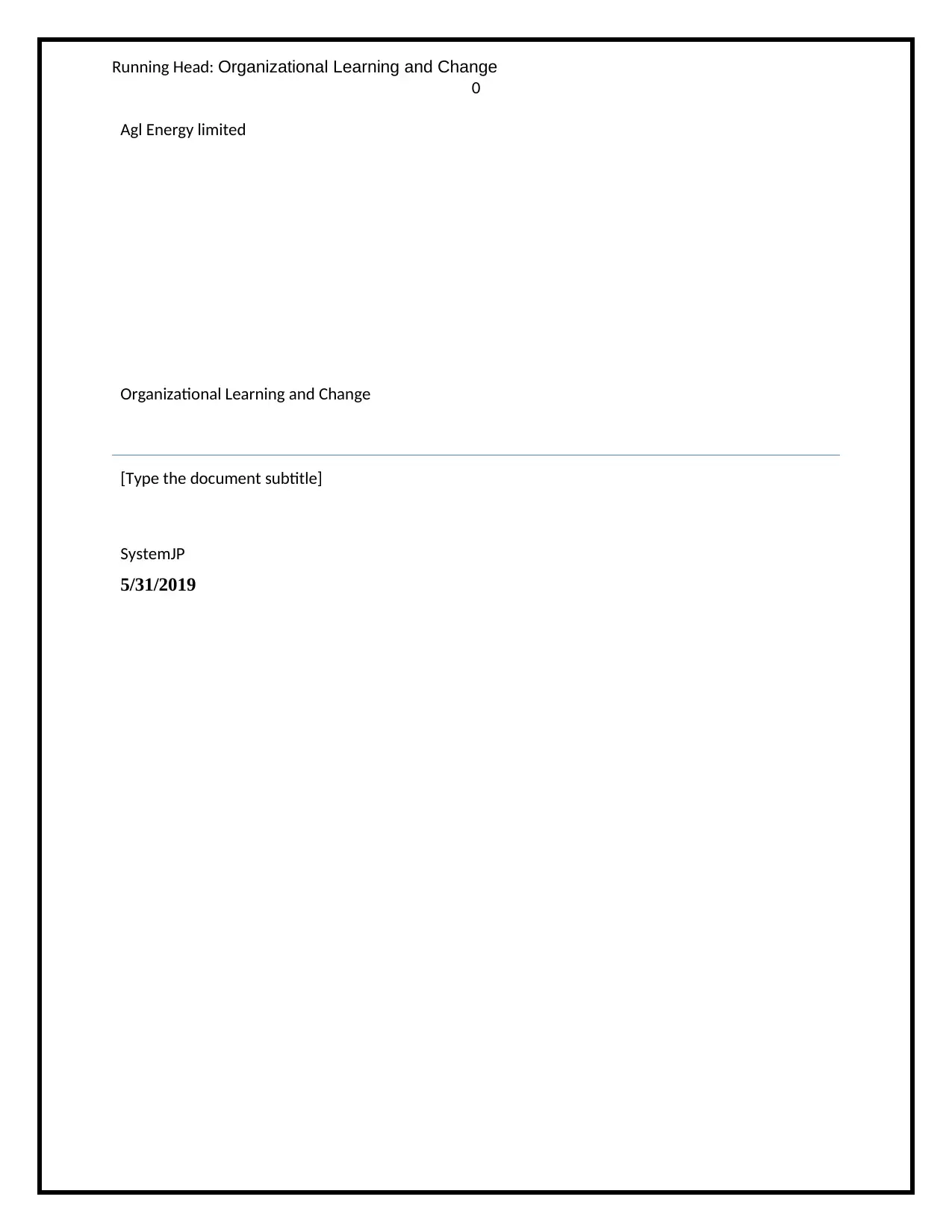
Running Head: Organizational Learning and Change
0
Agl Energy limited
Organizational Learning and Change
[Type the document subtitle]
SystemJP
5/31/2019
0
Agl Energy limited
Organizational Learning and Change
[Type the document subtitle]
SystemJP
5/31/2019
Paraphrase This Document
Need a fresh take? Get an instant paraphrase of this document with our AI Paraphraser
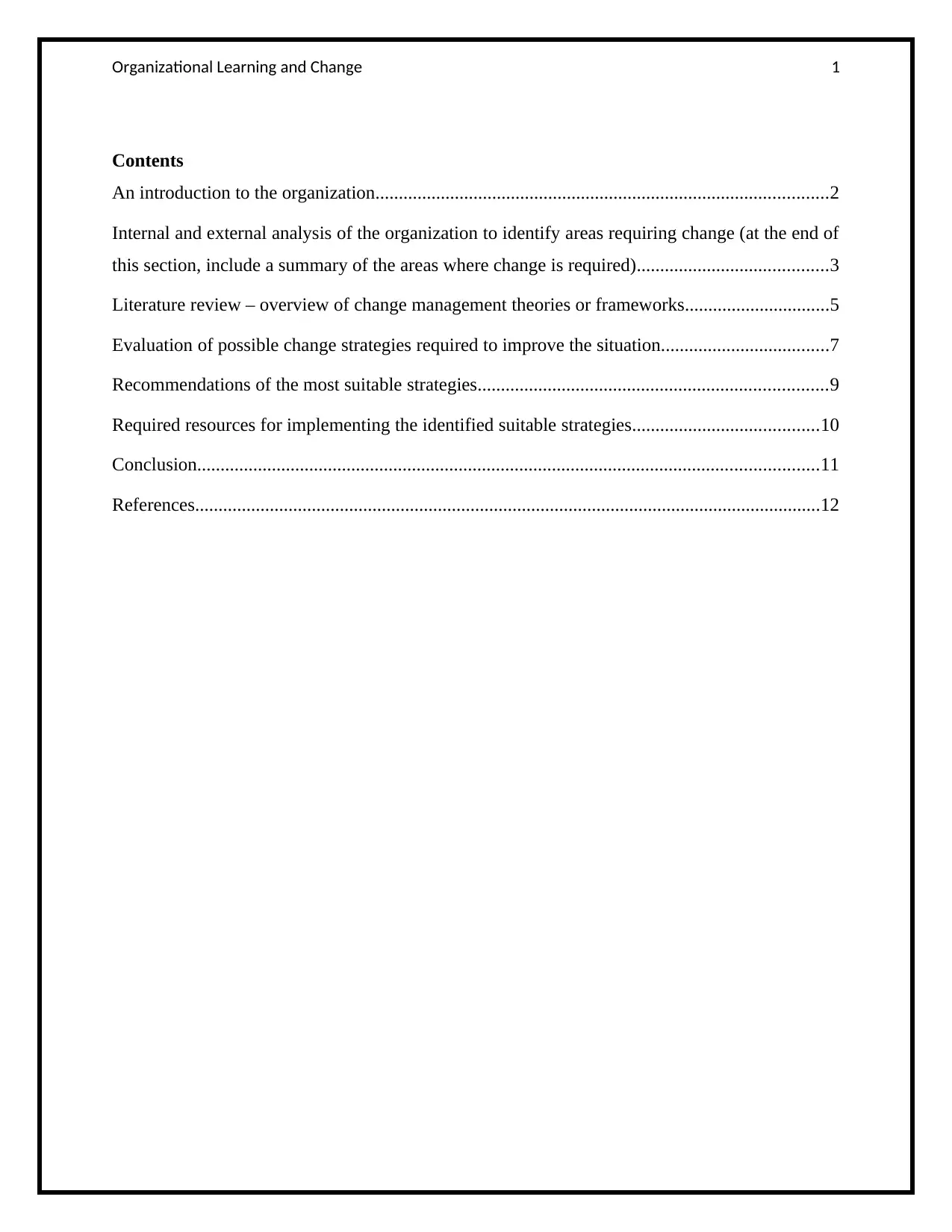
Organizational Learning and Change 1
Contents
An introduction to the organization.................................................................................................2
Internal and external analysis of the organization to identify areas requiring change (at the end of
this section, include a summary of the areas where change is required).........................................3
Literature review – overview of change management theories or frameworks...............................5
Evaluation of possible change strategies required to improve the situation....................................7
Recommendations of the most suitable strategies...........................................................................9
Required resources for implementing the identified suitable strategies........................................10
Conclusion.....................................................................................................................................11
References......................................................................................................................................12
Contents
An introduction to the organization.................................................................................................2
Internal and external analysis of the organization to identify areas requiring change (at the end of
this section, include a summary of the areas where change is required).........................................3
Literature review – overview of change management theories or frameworks...............................5
Evaluation of possible change strategies required to improve the situation....................................7
Recommendations of the most suitable strategies...........................................................................9
Required resources for implementing the identified suitable strategies........................................10
Conclusion.....................................................................................................................................11
References......................................................................................................................................12
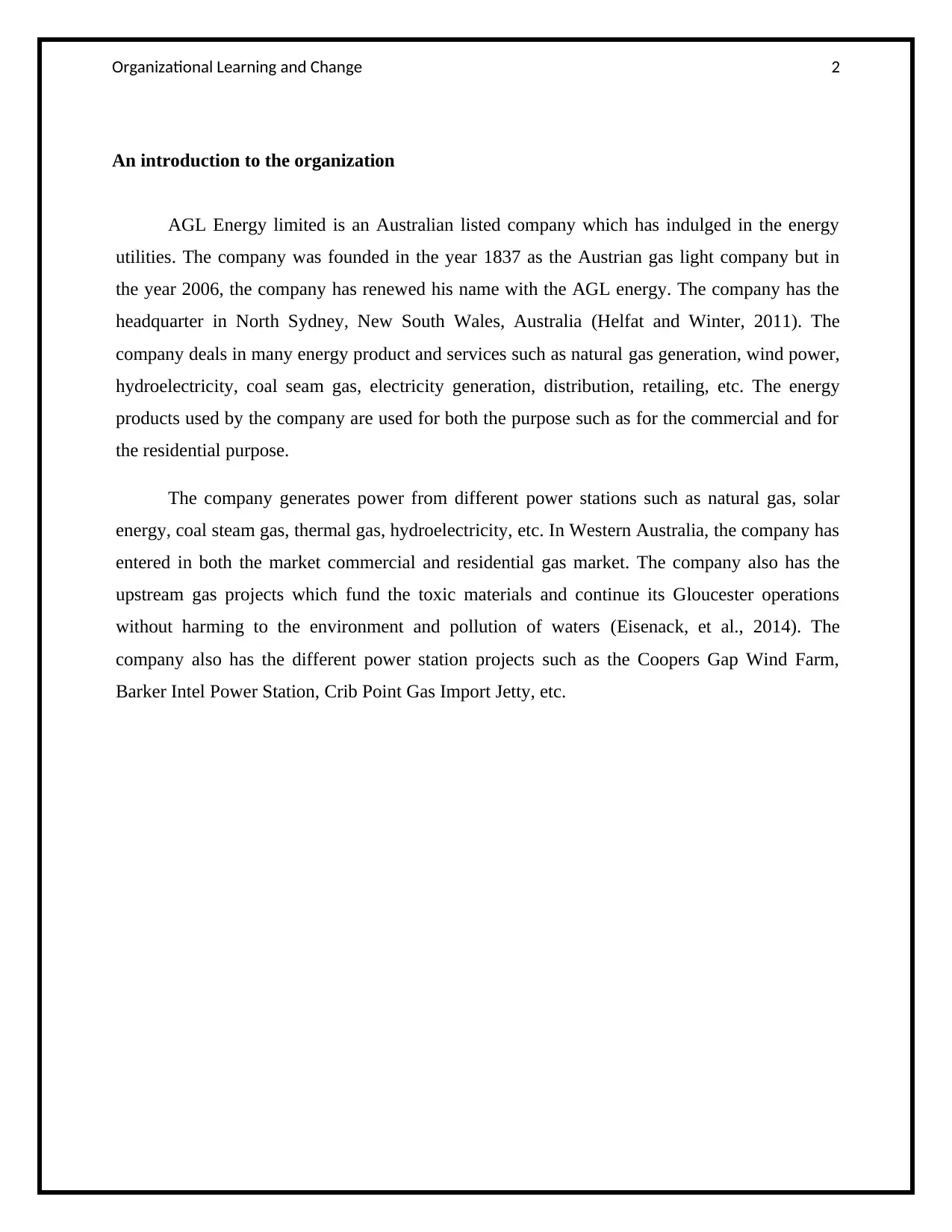
Organizational Learning and Change 2
An introduction to the organization
AGL Energy limited is an Australian listed company which has indulged in the energy
utilities. The company was founded in the year 1837 as the Austrian gas light company but in
the year 2006, the company has renewed his name with the AGL energy. The company has the
headquarter in North Sydney, New South Wales, Australia (Helfat and Winter, 2011). The
company deals in many energy product and services such as natural gas generation, wind power,
hydroelectricity, coal seam gas, electricity generation, distribution, retailing, etc. The energy
products used by the company are used for both the purpose such as for the commercial and for
the residential purpose.
The company generates power from different power stations such as natural gas, solar
energy, coal steam gas, thermal gas, hydroelectricity, etc. In Western Australia, the company has
entered in both the market commercial and residential gas market. The company also has the
upstream gas projects which fund the toxic materials and continue its Gloucester operations
without harming to the environment and pollution of waters (Eisenack, et al., 2014). The
company also has the different power station projects such as the Coopers Gap Wind Farm,
Barker Intel Power Station, Crib Point Gas Import Jetty, etc.
An introduction to the organization
AGL Energy limited is an Australian listed company which has indulged in the energy
utilities. The company was founded in the year 1837 as the Austrian gas light company but in
the year 2006, the company has renewed his name with the AGL energy. The company has the
headquarter in North Sydney, New South Wales, Australia (Helfat and Winter, 2011). The
company deals in many energy product and services such as natural gas generation, wind power,
hydroelectricity, coal seam gas, electricity generation, distribution, retailing, etc. The energy
products used by the company are used for both the purpose such as for the commercial and for
the residential purpose.
The company generates power from different power stations such as natural gas, solar
energy, coal steam gas, thermal gas, hydroelectricity, etc. In Western Australia, the company has
entered in both the market commercial and residential gas market. The company also has the
upstream gas projects which fund the toxic materials and continue its Gloucester operations
without harming to the environment and pollution of waters (Eisenack, et al., 2014). The
company also has the different power station projects such as the Coopers Gap Wind Farm,
Barker Intel Power Station, Crib Point Gas Import Jetty, etc.
⊘ This is a preview!⊘
Do you want full access?
Subscribe today to unlock all pages.

Trusted by 1+ million students worldwide
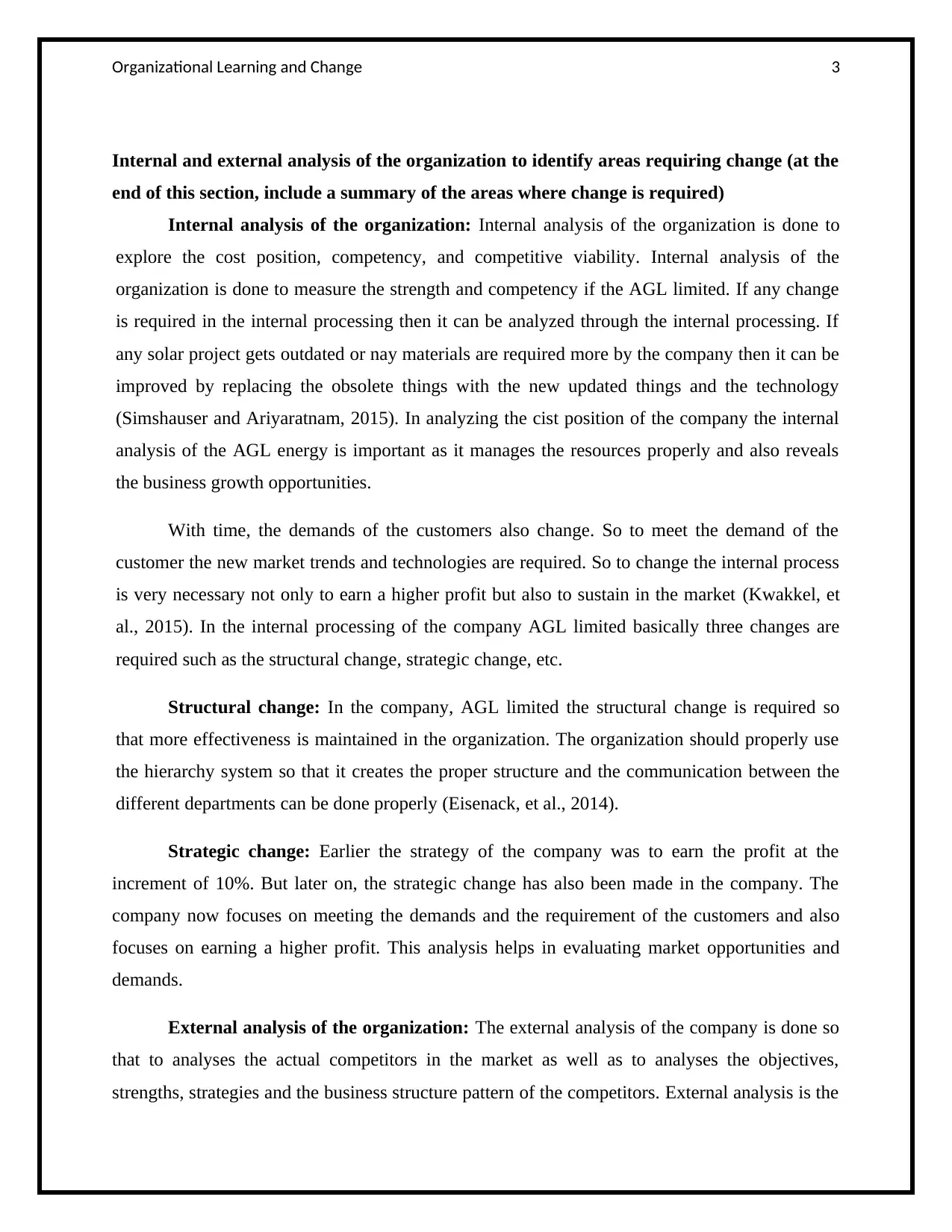
Organizational Learning and Change 3
Internal and external analysis of the organization to identify areas requiring change (at the
end of this section, include a summary of the areas where change is required)
Internal analysis of the organization: Internal analysis of the organization is done to
explore the cost position, competency, and competitive viability. Internal analysis of the
organization is done to measure the strength and competency if the AGL limited. If any change
is required in the internal processing then it can be analyzed through the internal processing. If
any solar project gets outdated or nay materials are required more by the company then it can be
improved by replacing the obsolete things with the new updated things and the technology
(Simshauser and Ariyaratnam, 2015). In analyzing the cist position of the company the internal
analysis of the AGL energy is important as it manages the resources properly and also reveals
the business growth opportunities.
With time, the demands of the customers also change. So to meet the demand of the
customer the new market trends and technologies are required. So to change the internal process
is very necessary not only to earn a higher profit but also to sustain in the market (Kwakkel, et
al., 2015). In the internal processing of the company AGL limited basically three changes are
required such as the structural change, strategic change, etc.
Structural change: In the company, AGL limited the structural change is required so
that more effectiveness is maintained in the organization. The organization should properly use
the hierarchy system so that it creates the proper structure and the communication between the
different departments can be done properly (Eisenack, et al., 2014).
Strategic change: Earlier the strategy of the company was to earn the profit at the
increment of 10%. But later on, the strategic change has also been made in the company. The
company now focuses on meeting the demands and the requirement of the customers and also
focuses on earning a higher profit. This analysis helps in evaluating market opportunities and
demands.
External analysis of the organization: The external analysis of the company is done so
that to analyses the actual competitors in the market as well as to analyses the objectives,
strengths, strategies and the business structure pattern of the competitors. External analysis is the
Internal and external analysis of the organization to identify areas requiring change (at the
end of this section, include a summary of the areas where change is required)
Internal analysis of the organization: Internal analysis of the organization is done to
explore the cost position, competency, and competitive viability. Internal analysis of the
organization is done to measure the strength and competency if the AGL limited. If any change
is required in the internal processing then it can be analyzed through the internal processing. If
any solar project gets outdated or nay materials are required more by the company then it can be
improved by replacing the obsolete things with the new updated things and the technology
(Simshauser and Ariyaratnam, 2015). In analyzing the cist position of the company the internal
analysis of the AGL energy is important as it manages the resources properly and also reveals
the business growth opportunities.
With time, the demands of the customers also change. So to meet the demand of the
customer the new market trends and technologies are required. So to change the internal process
is very necessary not only to earn a higher profit but also to sustain in the market (Kwakkel, et
al., 2015). In the internal processing of the company AGL limited basically three changes are
required such as the structural change, strategic change, etc.
Structural change: In the company, AGL limited the structural change is required so
that more effectiveness is maintained in the organization. The organization should properly use
the hierarchy system so that it creates the proper structure and the communication between the
different departments can be done properly (Eisenack, et al., 2014).
Strategic change: Earlier the strategy of the company was to earn the profit at the
increment of 10%. But later on, the strategic change has also been made in the company. The
company now focuses on meeting the demands and the requirement of the customers and also
focuses on earning a higher profit. This analysis helps in evaluating market opportunities and
demands.
External analysis of the organization: The external analysis of the company is done so
that to analyses the actual competitors in the market as well as to analyses the objectives,
strengths, strategies and the business structure pattern of the competitors. External analysis is the
Paraphrase This Document
Need a fresh take? Get an instant paraphrase of this document with our AI Paraphraser
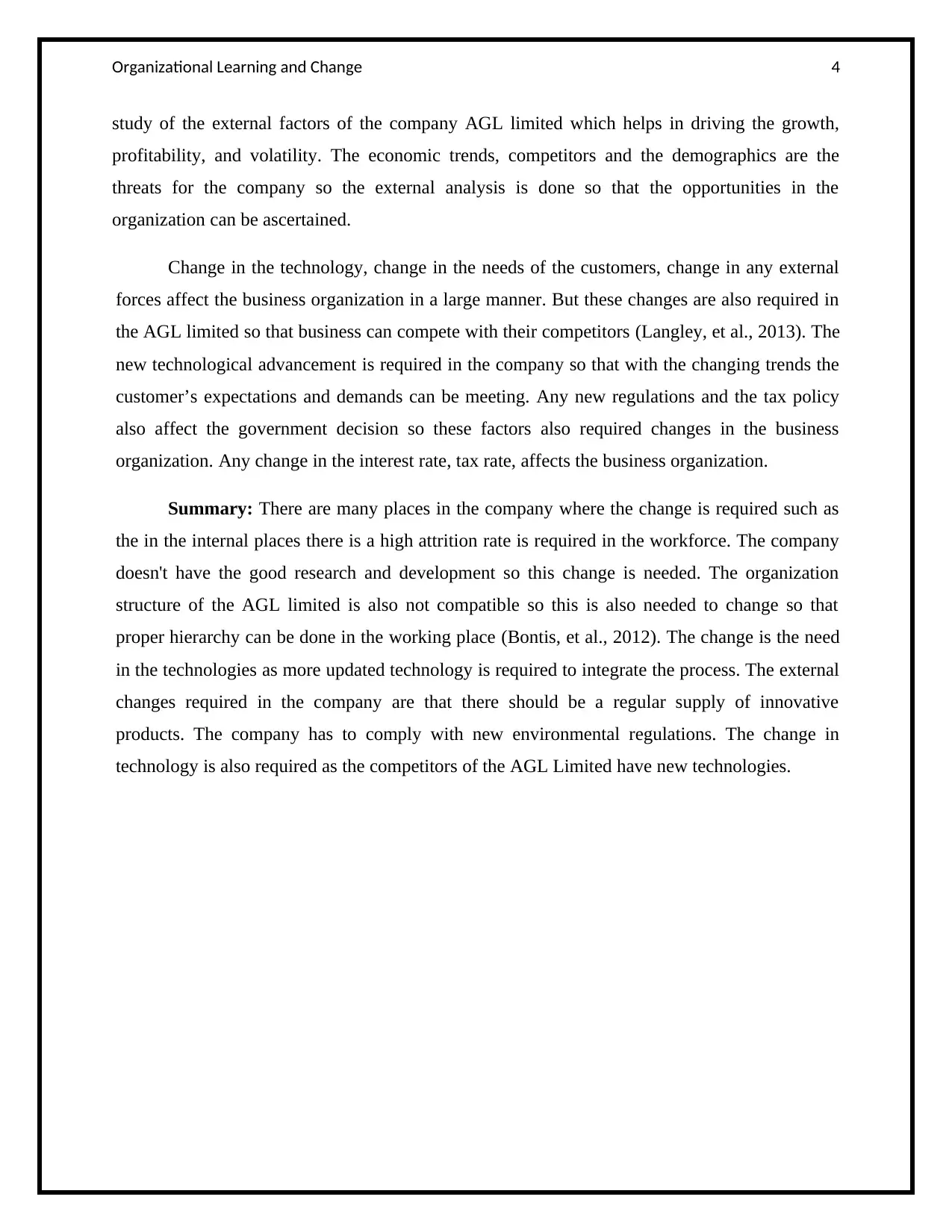
Organizational Learning and Change 4
study of the external factors of the company AGL limited which helps in driving the growth,
profitability, and volatility. The economic trends, competitors and the demographics are the
threats for the company so the external analysis is done so that the opportunities in the
organization can be ascertained.
Change in the technology, change in the needs of the customers, change in any external
forces affect the business organization in a large manner. But these changes are also required in
the AGL limited so that business can compete with their competitors (Langley, et al., 2013). The
new technological advancement is required in the company so that with the changing trends the
customer’s expectations and demands can be meeting. Any new regulations and the tax policy
also affect the government decision so these factors also required changes in the business
organization. Any change in the interest rate, tax rate, affects the business organization.
Summary: There are many places in the company where the change is required such as
the in the internal places there is a high attrition rate is required in the workforce. The company
doesn't have the good research and development so this change is needed. The organization
structure of the AGL limited is also not compatible so this is also needed to change so that
proper hierarchy can be done in the working place (Bontis, et al., 2012). The change is the need
in the technologies as more updated technology is required to integrate the process. The external
changes required in the company are that there should be a regular supply of innovative
products. The company has to comply with new environmental regulations. The change in
technology is also required as the competitors of the AGL Limited have new technologies.
study of the external factors of the company AGL limited which helps in driving the growth,
profitability, and volatility. The economic trends, competitors and the demographics are the
threats for the company so the external analysis is done so that the opportunities in the
organization can be ascertained.
Change in the technology, change in the needs of the customers, change in any external
forces affect the business organization in a large manner. But these changes are also required in
the AGL limited so that business can compete with their competitors (Langley, et al., 2013). The
new technological advancement is required in the company so that with the changing trends the
customer’s expectations and demands can be meeting. Any new regulations and the tax policy
also affect the government decision so these factors also required changes in the business
organization. Any change in the interest rate, tax rate, affects the business organization.
Summary: There are many places in the company where the change is required such as
the in the internal places there is a high attrition rate is required in the workforce. The company
doesn't have the good research and development so this change is needed. The organization
structure of the AGL limited is also not compatible so this is also needed to change so that
proper hierarchy can be done in the working place (Bontis, et al., 2012). The change is the need
in the technologies as more updated technology is required to integrate the process. The external
changes required in the company are that there should be a regular supply of innovative
products. The company has to comply with new environmental regulations. The change in
technology is also required as the competitors of the AGL Limited have new technologies.
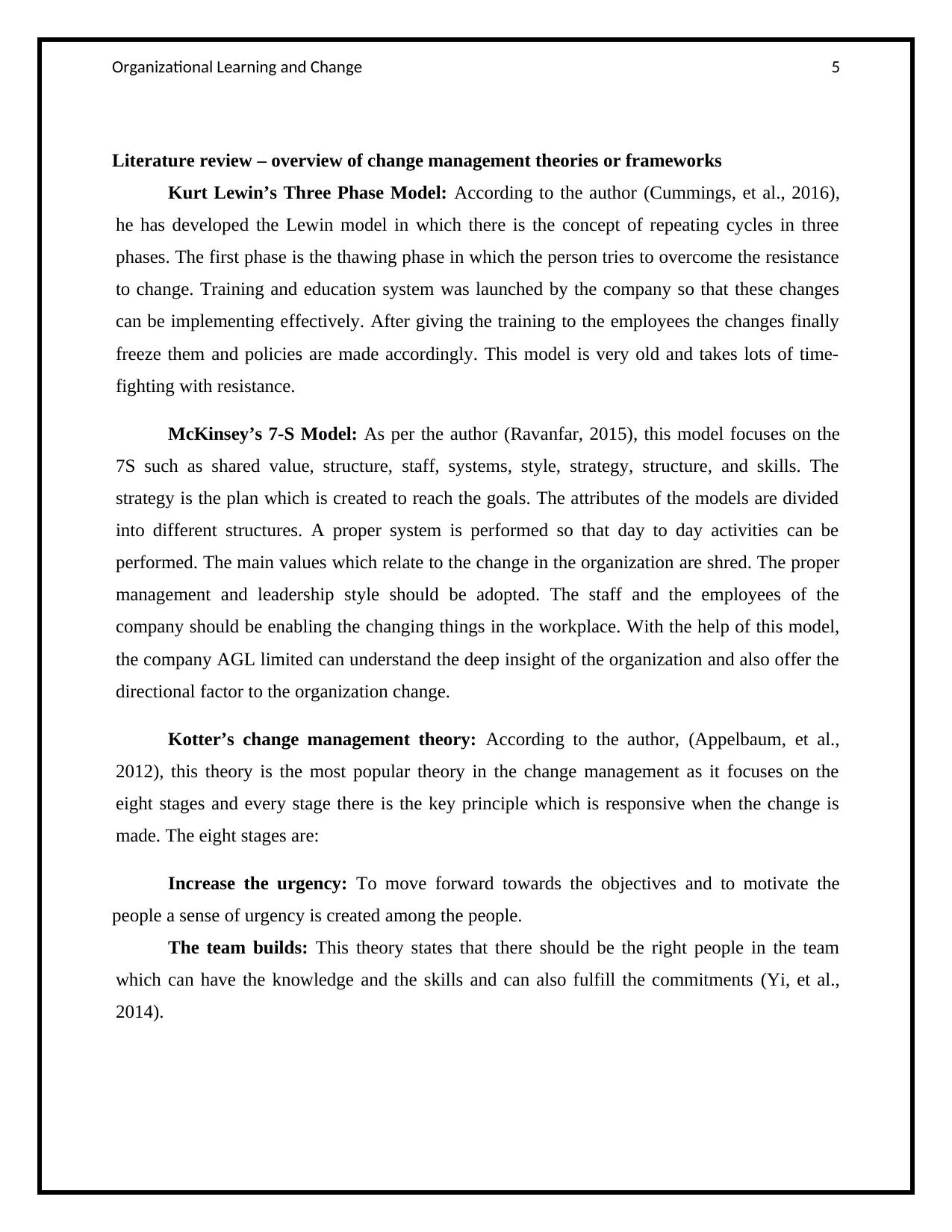
Organizational Learning and Change 5
Literature review – overview of change management theories or frameworks
Kurt Lewin’s Three Phase Model: According to the author (Cummings, et al., 2016),
he has developed the Lewin model in which there is the concept of repeating cycles in three
phases. The first phase is the thawing phase in which the person tries to overcome the resistance
to change. Training and education system was launched by the company so that these changes
can be implementing effectively. After giving the training to the employees the changes finally
freeze them and policies are made accordingly. This model is very old and takes lots of time-
fighting with resistance.
McKinsey’s 7-S Model: As per the author (Ravanfar, 2015), this model focuses on the
7S such as shared value, structure, staff, systems, style, strategy, structure, and skills. The
strategy is the plan which is created to reach the goals. The attributes of the models are divided
into different structures. A proper system is performed so that day to day activities can be
performed. The main values which relate to the change in the organization are shred. The proper
management and leadership style should be adopted. The staff and the employees of the
company should be enabling the changing things in the workplace. With the help of this model,
the company AGL limited can understand the deep insight of the organization and also offer the
directional factor to the organization change.
Kotter’s change management theory: According to the author, (Appelbaum, et al.,
2012), this theory is the most popular theory in the change management as it focuses on the
eight stages and every stage there is the key principle which is responsive when the change is
made. The eight stages are:
Increase the urgency: To move forward towards the objectives and to motivate the
people a sense of urgency is created among the people.
The team builds: This theory states that there should be the right people in the team
which can have the knowledge and the skills and can also fulfill the commitments (Yi, et al.,
2014).
Literature review – overview of change management theories or frameworks
Kurt Lewin’s Three Phase Model: According to the author (Cummings, et al., 2016),
he has developed the Lewin model in which there is the concept of repeating cycles in three
phases. The first phase is the thawing phase in which the person tries to overcome the resistance
to change. Training and education system was launched by the company so that these changes
can be implementing effectively. After giving the training to the employees the changes finally
freeze them and policies are made accordingly. This model is very old and takes lots of time-
fighting with resistance.
McKinsey’s 7-S Model: As per the author (Ravanfar, 2015), this model focuses on the
7S such as shared value, structure, staff, systems, style, strategy, structure, and skills. The
strategy is the plan which is created to reach the goals. The attributes of the models are divided
into different structures. A proper system is performed so that day to day activities can be
performed. The main values which relate to the change in the organization are shred. The proper
management and leadership style should be adopted. The staff and the employees of the
company should be enabling the changing things in the workplace. With the help of this model,
the company AGL limited can understand the deep insight of the organization and also offer the
directional factor to the organization change.
Kotter’s change management theory: According to the author, (Appelbaum, et al.,
2012), this theory is the most popular theory in the change management as it focuses on the
eight stages and every stage there is the key principle which is responsive when the change is
made. The eight stages are:
Increase the urgency: To move forward towards the objectives and to motivate the
people a sense of urgency is created among the people.
The team builds: This theory states that there should be the right people in the team
which can have the knowledge and the skills and can also fulfill the commitments (Yi, et al.,
2014).
⊘ This is a preview!⊘
Do you want full access?
Subscribe today to unlock all pages.

Trusted by 1+ million students worldwide

Organizational Learning and Change 6
Get the vision correct: Another stage of this model is that the vision should be correct.
In the right vision, everything is taking into the account such as the emotional connect, creativity
and the objectives.
Communicate: As per this theory, it is very important to tell the employees and
communicate them with the change and its need.
Get things moving: The support is required in the organization when the things are
moving and empowering actions are taken. To empower the actions the roadblocks are removed
and feedbacks are implemented in a constructive way.
Focus on short term goals: To achieve success it is very important to divide the ultimate
goals into the small parts. When the goals are short term the success can be achieved without
any stress (Fiol and Lyles, 2016).
Don’t give up: As per the Kotter’s it is important to not to give up in the organization
then only the success is achieved. When in the organization any change happens, it doesn’t
matter how tough it is, the persistence should be maintained.
Incorporate change: When the change is made effectively in the organization then it is
important to reinforce and make the part of the workplace culture.
This theory is very easy to follow in the working place. This theory has the main motive is to
accept the change which is made in the organization instead of opposing that.
Get the vision correct: Another stage of this model is that the vision should be correct.
In the right vision, everything is taking into the account such as the emotional connect, creativity
and the objectives.
Communicate: As per this theory, it is very important to tell the employees and
communicate them with the change and its need.
Get things moving: The support is required in the organization when the things are
moving and empowering actions are taken. To empower the actions the roadblocks are removed
and feedbacks are implemented in a constructive way.
Focus on short term goals: To achieve success it is very important to divide the ultimate
goals into the small parts. When the goals are short term the success can be achieved without
any stress (Fiol and Lyles, 2016).
Don’t give up: As per the Kotter’s it is important to not to give up in the organization
then only the success is achieved. When in the organization any change happens, it doesn’t
matter how tough it is, the persistence should be maintained.
Incorporate change: When the change is made effectively in the organization then it is
important to reinforce and make the part of the workplace culture.
This theory is very easy to follow in the working place. This theory has the main motive is to
accept the change which is made in the organization instead of opposing that.
Paraphrase This Document
Need a fresh take? Get an instant paraphrase of this document with our AI Paraphraser

Organizational Learning and Change 7
Evaluation of possible change strategies required to improve the situation.
Change management strategies are required in the company AGL Limited as it helps in
making something different. Change management strategies help in describing certain things
such as inventory requirements, changes in the supply chain, etc. Change management strategies
and plans are very essential in the company so that the growth and improvement can be done in
the organization (Xu, et al., 2014). The main aim of the change management’s strategy is to
establish the culture of creativity and to improve the employees for the betterment. Change
management strategies are required in the company AGL limited so that communication can be
done properly, digital literacy can be maintained in the organization, etc. When the change in the
technology is made the possible change strategies are adopted so that situations can be improved.
The dynamics of strategic organizational change is a critical issue in the fostering
positive way. It is very important to examine the fundamental issues and the dynamic
surroundings of the AGL energy limited so that any dynamic change will not affect the
organization much (Valters, 2015). Strategic changes are needed in the company when
enhancement of the leadership approached is done in the company so that the motivation,
commitment, and employee participation can be done. The attributes of the corporate culture
have to be done by the company so that the new challenges in the company can be easily met.
To improve the changing situation the company has to understand that how to people will
behave, the company has to motivate their employees and they have to show the positive
attitudes that the change can lead to the success in the organization. Not only by motivating
them but also by making the work as the team and offering the other benefits with the dynamic
change can improve the situation. The company face many challenges as there were many issues
build up in the energy products and services strategic change is required in the company to
manage the change in a structured way. The objectives, goals, and missions can also be achieved
by motivating and boosting the employees towards the change. (Jones, 2013).
Role of, and the relationship between, individuals, teams, and leaders in the change process
Individual role in the change process: When any change is made in the company in
terms of the internal and the external change than individual works more on the how to make
that change successful in the company. He motivates himself that this change will bring the best
Evaluation of possible change strategies required to improve the situation.
Change management strategies are required in the company AGL Limited as it helps in
making something different. Change management strategies help in describing certain things
such as inventory requirements, changes in the supply chain, etc. Change management strategies
and plans are very essential in the company so that the growth and improvement can be done in
the organization (Xu, et al., 2014). The main aim of the change management’s strategy is to
establish the culture of creativity and to improve the employees for the betterment. Change
management strategies are required in the company AGL limited so that communication can be
done properly, digital literacy can be maintained in the organization, etc. When the change in the
technology is made the possible change strategies are adopted so that situations can be improved.
The dynamics of strategic organizational change is a critical issue in the fostering
positive way. It is very important to examine the fundamental issues and the dynamic
surroundings of the AGL energy limited so that any dynamic change will not affect the
organization much (Valters, 2015). Strategic changes are needed in the company when
enhancement of the leadership approached is done in the company so that the motivation,
commitment, and employee participation can be done. The attributes of the corporate culture
have to be done by the company so that the new challenges in the company can be easily met.
To improve the changing situation the company has to understand that how to people will
behave, the company has to motivate their employees and they have to show the positive
attitudes that the change can lead to the success in the organization. Not only by motivating
them but also by making the work as the team and offering the other benefits with the dynamic
change can improve the situation. The company face many challenges as there were many issues
build up in the energy products and services strategic change is required in the company to
manage the change in a structured way. The objectives, goals, and missions can also be achieved
by motivating and boosting the employees towards the change. (Jones, 2013).
Role of, and the relationship between, individuals, teams, and leaders in the change process
Individual role in the change process: When any change is made in the company in
terms of the internal and the external change than individual works more on the how to make
that change successful in the company. He motivates himself that this change will bring the best
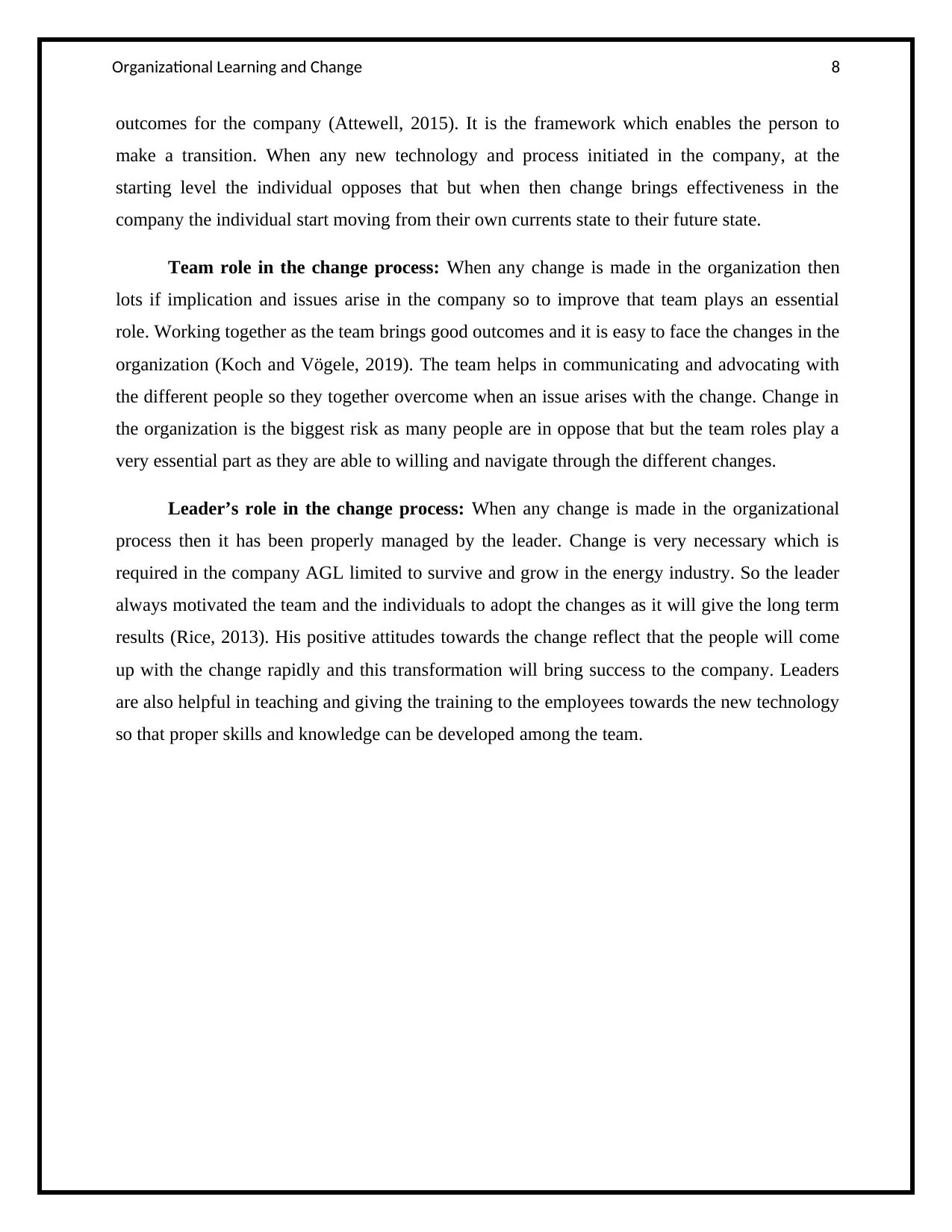
Organizational Learning and Change 8
outcomes for the company (Attewell, 2015). It is the framework which enables the person to
make a transition. When any new technology and process initiated in the company, at the
starting level the individual opposes that but when then change brings effectiveness in the
company the individual start moving from their own currents state to their future state.
Team role in the change process: When any change is made in the organization then
lots if implication and issues arise in the company so to improve that team plays an essential
role. Working together as the team brings good outcomes and it is easy to face the changes in the
organization (Koch and Vögele, 2019). The team helps in communicating and advocating with
the different people so they together overcome when an issue arises with the change. Change in
the organization is the biggest risk as many people are in oppose that but the team roles play a
very essential part as they are able to willing and navigate through the different changes.
Leader’s role in the change process: When any change is made in the organizational
process then it has been properly managed by the leader. Change is very necessary which is
required in the company AGL limited to survive and grow in the energy industry. So the leader
always motivated the team and the individuals to adopt the changes as it will give the long term
results (Rice, 2013). His positive attitudes towards the change reflect that the people will come
up with the change rapidly and this transformation will bring success to the company. Leaders
are also helpful in teaching and giving the training to the employees towards the new technology
so that proper skills and knowledge can be developed among the team.
outcomes for the company (Attewell, 2015). It is the framework which enables the person to
make a transition. When any new technology and process initiated in the company, at the
starting level the individual opposes that but when then change brings effectiveness in the
company the individual start moving from their own currents state to their future state.
Team role in the change process: When any change is made in the organization then
lots if implication and issues arise in the company so to improve that team plays an essential
role. Working together as the team brings good outcomes and it is easy to face the changes in the
organization (Koch and Vögele, 2019). The team helps in communicating and advocating with
the different people so they together overcome when an issue arises with the change. Change in
the organization is the biggest risk as many people are in oppose that but the team roles play a
very essential part as they are able to willing and navigate through the different changes.
Leader’s role in the change process: When any change is made in the organizational
process then it has been properly managed by the leader. Change is very necessary which is
required in the company AGL limited to survive and grow in the energy industry. So the leader
always motivated the team and the individuals to adopt the changes as it will give the long term
results (Rice, 2013). His positive attitudes towards the change reflect that the people will come
up with the change rapidly and this transformation will bring success to the company. Leaders
are also helpful in teaching and giving the training to the employees towards the new technology
so that proper skills and knowledge can be developed among the team.
⊘ This is a preview!⊘
Do you want full access?
Subscribe today to unlock all pages.

Trusted by 1+ million students worldwide
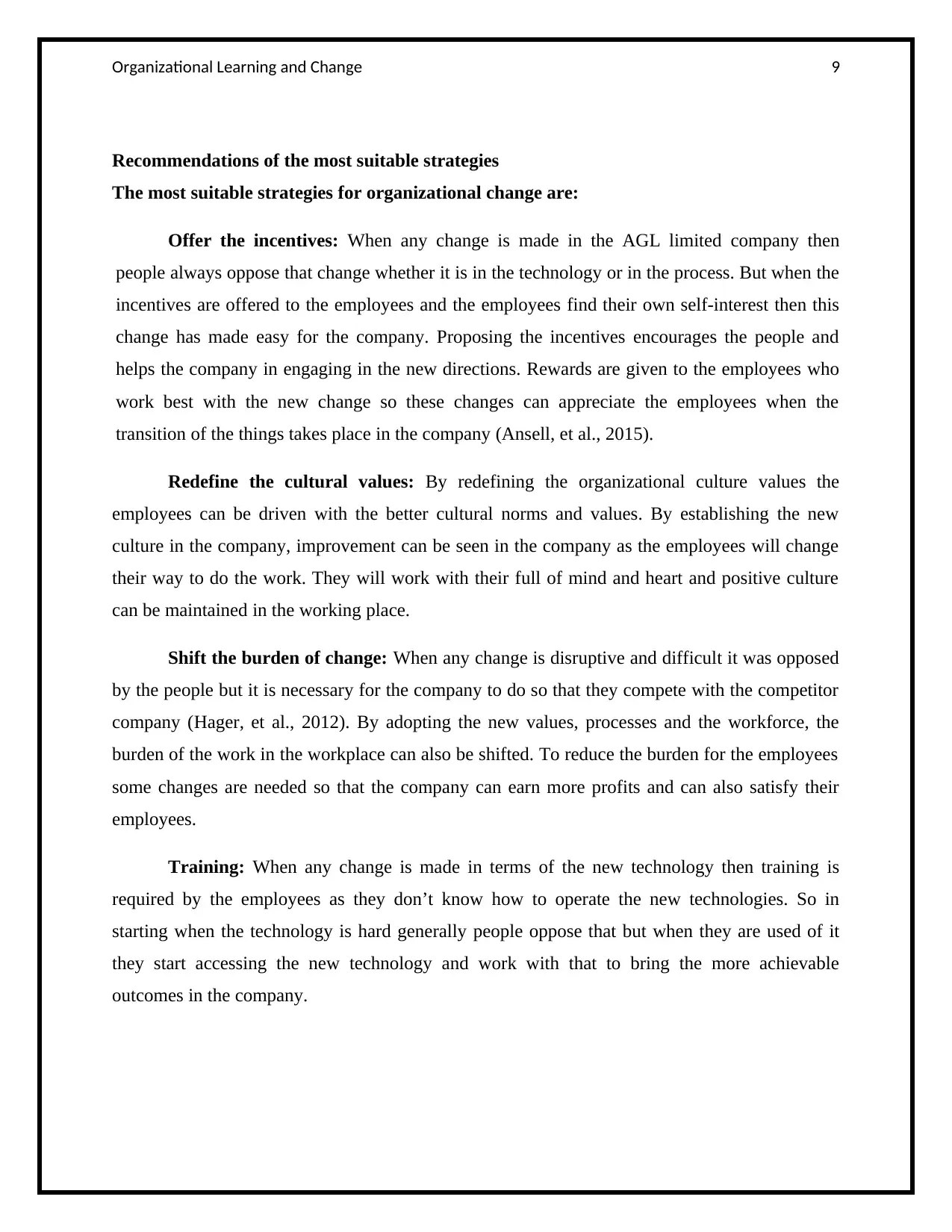
Organizational Learning and Change 9
Recommendations of the most suitable strategies
The most suitable strategies for organizational change are:
Offer the incentives: When any change is made in the AGL limited company then
people always oppose that change whether it is in the technology or in the process. But when the
incentives are offered to the employees and the employees find their own self-interest then this
change has made easy for the company. Proposing the incentives encourages the people and
helps the company in engaging in the new directions. Rewards are given to the employees who
work best with the new change so these changes can appreciate the employees when the
transition of the things takes place in the company (Ansell, et al., 2015).
Redefine the cultural values: By redefining the organizational culture values the
employees can be driven with the better cultural norms and values. By establishing the new
culture in the company, improvement can be seen in the company as the employees will change
their way to do the work. They will work with their full of mind and heart and positive culture
can be maintained in the working place.
Shift the burden of change: When any change is disruptive and difficult it was opposed
by the people but it is necessary for the company to do so that they compete with the competitor
company (Hager, et al., 2012). By adopting the new values, processes and the workforce, the
burden of the work in the workplace can also be shifted. To reduce the burden for the employees
some changes are needed so that the company can earn more profits and can also satisfy their
employees.
Training: When any change is made in terms of the new technology then training is
required by the employees as they don’t know how to operate the new technologies. So in
starting when the technology is hard generally people oppose that but when they are used of it
they start accessing the new technology and work with that to bring the more achievable
outcomes in the company.
Recommendations of the most suitable strategies
The most suitable strategies for organizational change are:
Offer the incentives: When any change is made in the AGL limited company then
people always oppose that change whether it is in the technology or in the process. But when the
incentives are offered to the employees and the employees find their own self-interest then this
change has made easy for the company. Proposing the incentives encourages the people and
helps the company in engaging in the new directions. Rewards are given to the employees who
work best with the new change so these changes can appreciate the employees when the
transition of the things takes place in the company (Ansell, et al., 2015).
Redefine the cultural values: By redefining the organizational culture values the
employees can be driven with the better cultural norms and values. By establishing the new
culture in the company, improvement can be seen in the company as the employees will change
their way to do the work. They will work with their full of mind and heart and positive culture
can be maintained in the working place.
Shift the burden of change: When any change is disruptive and difficult it was opposed
by the people but it is necessary for the company to do so that they compete with the competitor
company (Hager, et al., 2012). By adopting the new values, processes and the workforce, the
burden of the work in the workplace can also be shifted. To reduce the burden for the employees
some changes are needed so that the company can earn more profits and can also satisfy their
employees.
Training: When any change is made in terms of the new technology then training is
required by the employees as they don’t know how to operate the new technologies. So in
starting when the technology is hard generally people oppose that but when they are used of it
they start accessing the new technology and work with that to bring the more achievable
outcomes in the company.
Paraphrase This Document
Need a fresh take? Get an instant paraphrase of this document with our AI Paraphraser
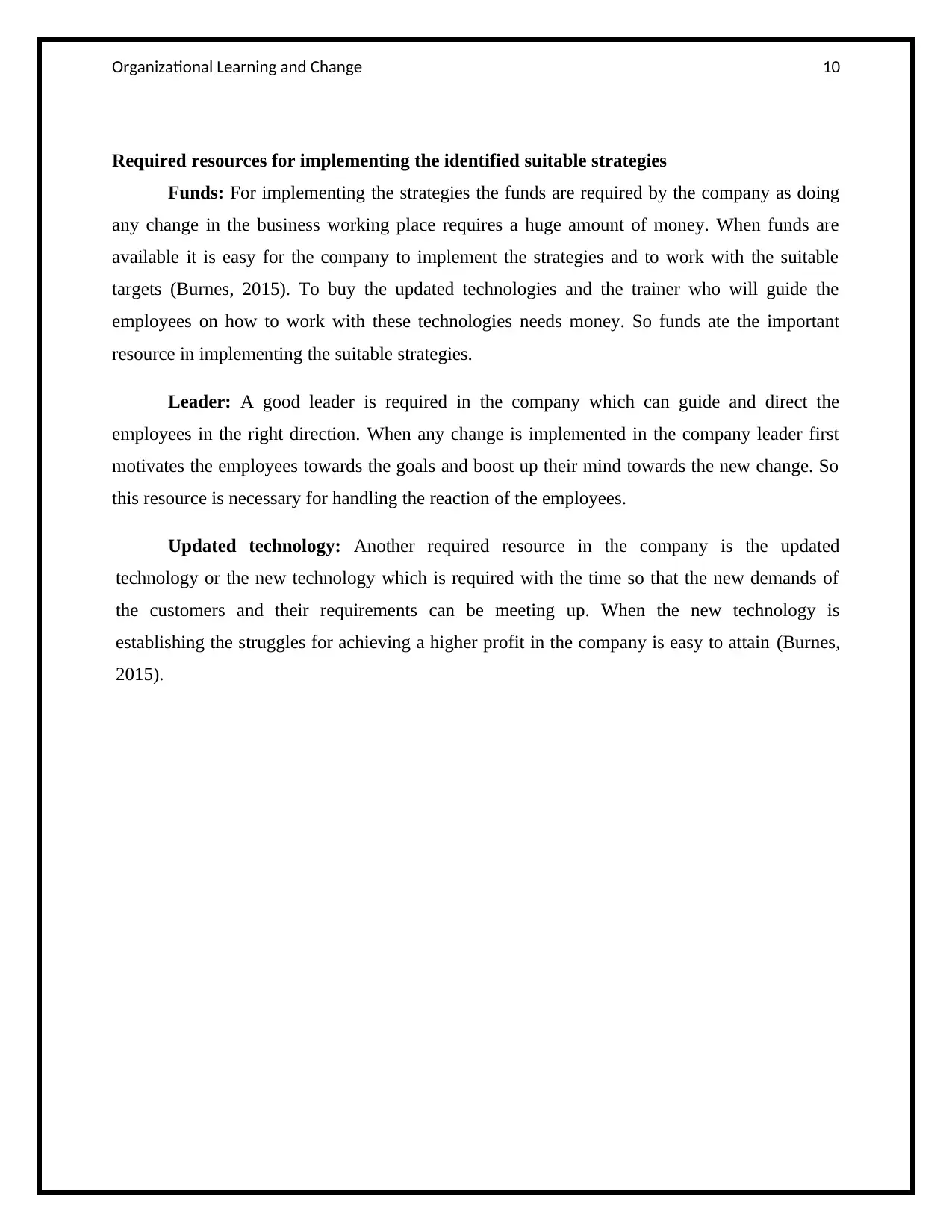
Organizational Learning and Change 10
Required resources for implementing the identified suitable strategies
Funds: For implementing the strategies the funds are required by the company as doing
any change in the business working place requires a huge amount of money. When funds are
available it is easy for the company to implement the strategies and to work with the suitable
targets (Burnes, 2015). To buy the updated technologies and the trainer who will guide the
employees on how to work with these technologies needs money. So funds ate the important
resource in implementing the suitable strategies.
Leader: A good leader is required in the company which can guide and direct the
employees in the right direction. When any change is implemented in the company leader first
motivates the employees towards the goals and boost up their mind towards the new change. So
this resource is necessary for handling the reaction of the employees.
Updated technology: Another required resource in the company is the updated
technology or the new technology which is required with the time so that the new demands of
the customers and their requirements can be meeting up. When the new technology is
establishing the struggles for achieving a higher profit in the company is easy to attain (Burnes,
2015).
Required resources for implementing the identified suitable strategies
Funds: For implementing the strategies the funds are required by the company as doing
any change in the business working place requires a huge amount of money. When funds are
available it is easy for the company to implement the strategies and to work with the suitable
targets (Burnes, 2015). To buy the updated technologies and the trainer who will guide the
employees on how to work with these technologies needs money. So funds ate the important
resource in implementing the suitable strategies.
Leader: A good leader is required in the company which can guide and direct the
employees in the right direction. When any change is implemented in the company leader first
motivates the employees towards the goals and boost up their mind towards the new change. So
this resource is necessary for handling the reaction of the employees.
Updated technology: Another required resource in the company is the updated
technology or the new technology which is required with the time so that the new demands of
the customers and their requirements can be meeting up. When the new technology is
establishing the struggles for achieving a higher profit in the company is easy to attain (Burnes,
2015).

Organizational Learning and Change 11
Conclusion
From the above report, it is concluded that organization change is very important in the
company as it helps in improving the growth and attaining the objectives. With the time the
technology and the processing of the company get obsoleted so the organization change is
essential so that the up gradation in the business processing of the AGL limited can be done. In
this report, different theories of the organization learning have explained which helps in
overcoming with the changes properly. The dynamics of strategic organization change has
explained which helps in examining the fundamental issues and the dynamic surroundings of the
AGL energy limited. The report also states the role of the team, individual and the leader in the
change process. The need to change the technology and the processing of working is very
important in the AGL limited company so that more profits and the growth can be achieved in
the energy industry.
Conclusion
From the above report, it is concluded that organization change is very important in the
company as it helps in improving the growth and attaining the objectives. With the time the
technology and the processing of the company get obsoleted so the organization change is
essential so that the up gradation in the business processing of the AGL limited can be done. In
this report, different theories of the organization learning have explained which helps in
overcoming with the changes properly. The dynamics of strategic organization change has
explained which helps in examining the fundamental issues and the dynamic surroundings of the
AGL energy limited. The report also states the role of the team, individual and the leader in the
change process. The need to change the technology and the processing of working is very
important in the AGL limited company so that more profits and the growth can be achieved in
the energy industry.
⊘ This is a preview!⊘
Do you want full access?
Subscribe today to unlock all pages.

Trusted by 1+ million students worldwide
1 out of 15
Related Documents
Your All-in-One AI-Powered Toolkit for Academic Success.
+13062052269
info@desklib.com
Available 24*7 on WhatsApp / Email
![[object Object]](/_next/static/media/star-bottom.7253800d.svg)
Unlock your academic potential
Copyright © 2020–2025 A2Z Services. All Rights Reserved. Developed and managed by ZUCOL.





